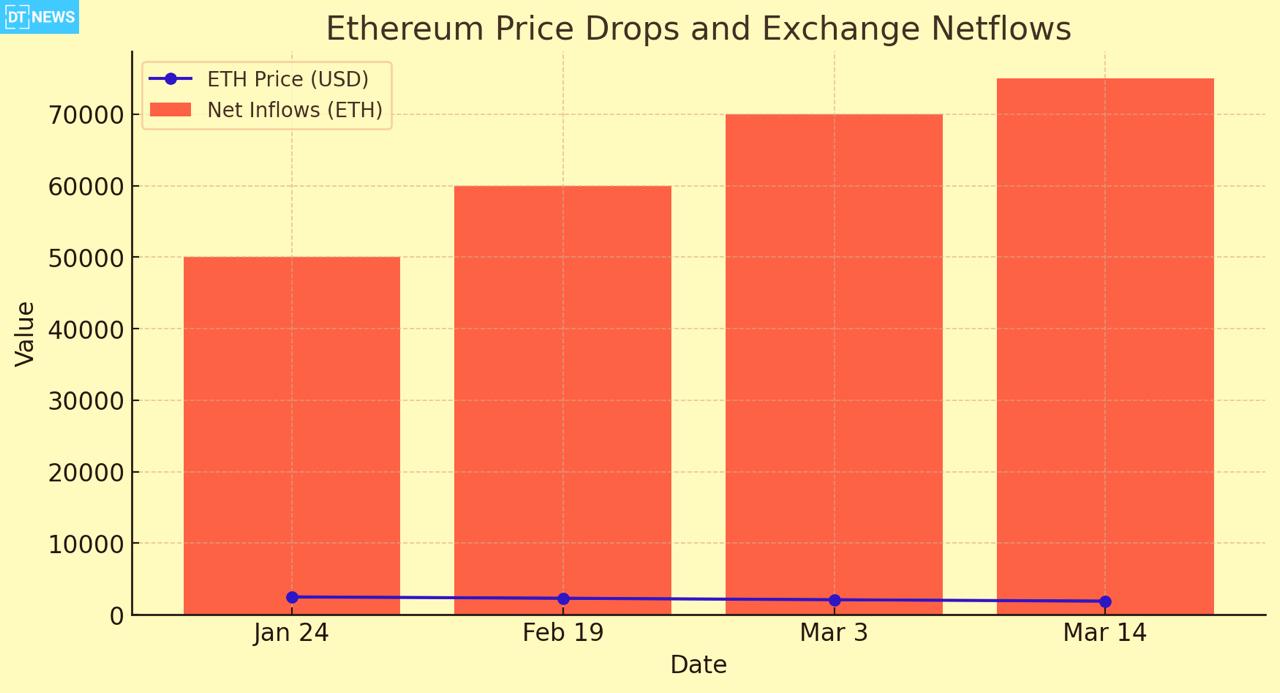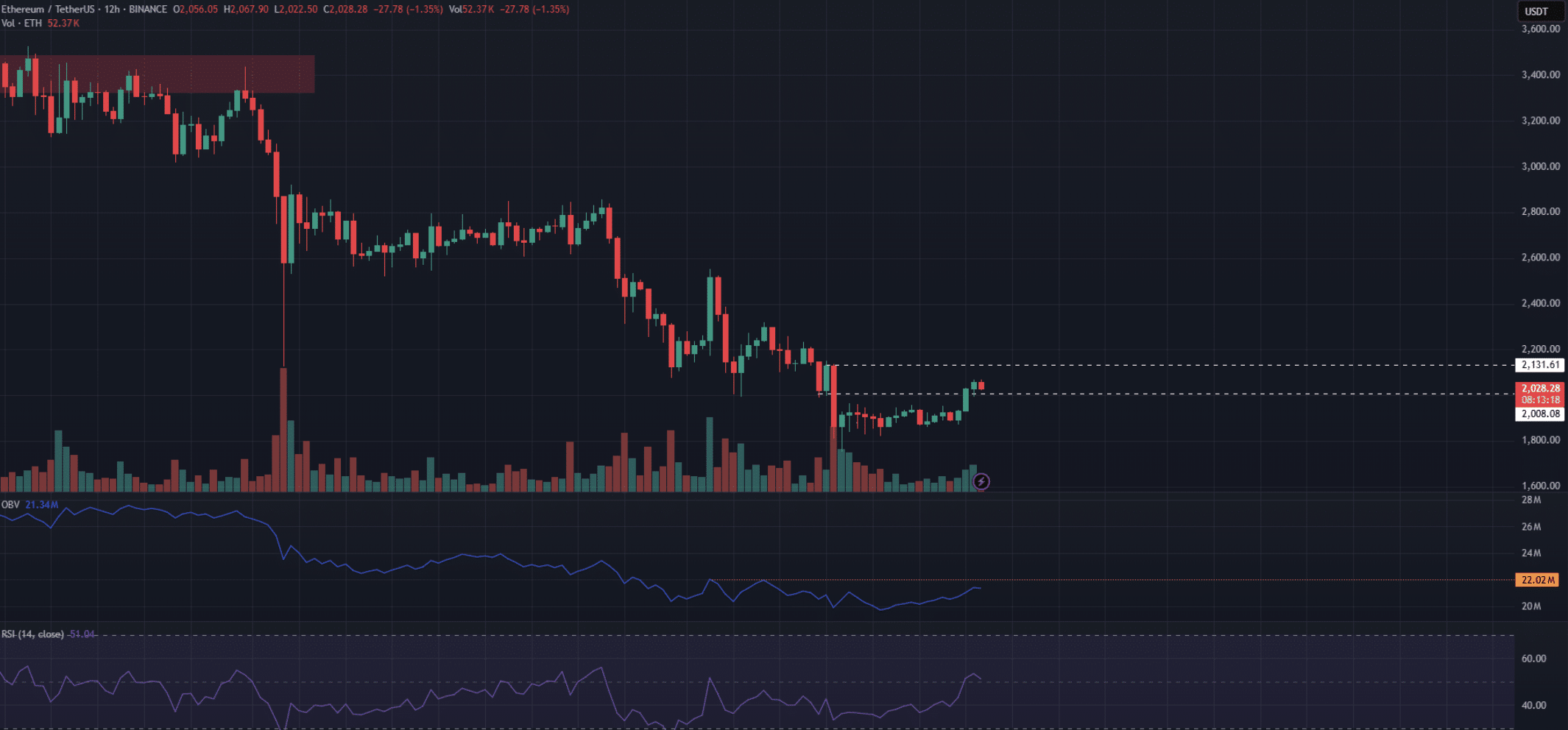 CaryptosHeadlines Media Has Launched Its Native Token CHT.
Airdrop Is Live For Everyone, Claim Instant 5000 CHT Tokens Worth Of $50 USDT.
Join the Airdrop at the official website,
CryptosHeadlinesToken.com
CaryptosHeadlines Media Has Launched Its Native Token CHT.
Airdrop Is Live For Everyone, Claim Instant 5000 CHT Tokens Worth Of $50 USDT.
Join the Airdrop at the official website,
CryptosHeadlinesToken.com
Ethereum (ETH) has witnessed a 10% price surge since Tuesday’s lows, breaking past the $2,000 psychological level. However, market indicators and on-chain metrics suggest that this rally may be short-lived. Historical netflow patterns and derivatives data indicate that selling pressure may soon rise, potentially leading to another decline in ETH’s price.
With macroeconomic conditions uncertain and the U.S. Federal Reserve signaling two rate cuts for 2025, Ethereum’s upward momentum faces fundamental headwinds. Market sentiment remains cautiously bullish, but recent data suggests that traders should be prepared for potential volatility.
Technical Indicators Signal Potential Reversal
Ethereum’s technical indicators are flashing mixed signals, making it crucial for traders to analyze price action, volume, and momentum indicators before making trading decisions. While the RSI has indicated short-term strength, the OBV has not confirmed sustained buying activity. The recent price spike may be a liquidity grab rather than a true trend reversal. Given the lack of strong bullish confirmation, traders should watch key resistance and support levels to assess whether ETH will continue climbing or face a potential reversal.
| Indicator | Signal | Interpretation | Notes |
|---|---|---|---|
| RSI (Relative Strength Index) | Bullish (Short-term) | Indicates short-term bullish trend | However, may not confirm long-term bullish trend |
| OBV (On-Balance Volume) | Neutral/Weak | Does not confirm sustained buying activity | Lack of volume confirmation for sustained uptrend |
| Price Action Beyond $2,000 | Liquidity Grab | Price surge may be a short-term liquidity hunt | Fragile structure suggests potential retracement |
Ethereum’s 1-day price chart shows mixed signals. While RSI (Relative Strength Index) has indicated a short-term bullish trend, On-Balance Volume (OBV) has not confirmed the shift in momentum. The price movement beyond $2,000 may be a liquidity hunt, rather than the start of a sustained uptrend.
“Ethereum’s latest price move lacks the necessary volume confirmation for a strong bullish shift. The structure remains fragile, suggesting that the price may retrace in the coming days.” — Market Analyst, David Lin
Additionally, market sentiment remains broadly fearful, suggesting that traders are still hesitant to enter long positions aggressively. ETH may struggle to maintain its current price levels without significant buying volume.


On-Chain Data Highlights Selling Pressure
Ethereum’s exchange netflows provide key insights into whether traders are accumulating or selling their ETH holdings. Historically, spikes in net inflows to exchanges have been followed by price drops, indicating increased selling pressure. Over the past two months, Ethereum has seen multiple high inflow days that resulted in price declines. If this trend continues, ETH’s current rally may be short-lived. Investors should monitor netflow trends closely, as they often provide early warning signs of potential market downturns.
Ethereum exchange netflows track the difference between ETH inflows and outflows from centralized exchanges. Higher inflows suggest increased selling activity, while outflows indicate accumulation.


Over the past two months, ETH net flows have followed a predictable pattern:
- January 24: Large inflows led to a price drop.
- February 19: Another spike in inflows resulted in further downside.
- March 3 & 14: Similar trends saw ETH decline sharply after substantial exchange deposits.
“Historical trends suggest that ETH’s recent inflows could trigger a repeat scenario. If netflows continue rising, another price decline may be imminent.” — Blockchain Researcher, Alice Morgan
If this pattern holds, Ethereum could be primed for another downward move in the coming days, potentially revisiting $1,750 or lower.
Derivatives Market Data Points to Bearish Sentiment
Ethereum’s derivatives market offers another layer of insight into trader sentiment. The taker buy/sell ratio, which measures market order activity in perpetual contracts, has remained negative over the past three weeks. This suggests that bears are still in control, with more traders placing sell orders than buy orders. Even though ETH saw a temporary uptick in taker buy volume, this shift was short-lived. If bearish dominance persists, it could further weaken ETH’s ability to sustain its current price levels.
Derivatives Market Data (Taker Buy/Sell Ratio)
| Metric | Trend | Impact | Notes |
|---|---|---|---|
| Taker Buy/Sell Ratio (Last 3 weeks) | Negative | Bearish sentiment | Bears dominate market activity, more sell orders than buys |
| Temporary Bullish Shift | Short-lived | Limited upside | Brief uptick in buy volume, but no sustained bullish trend |
| 7-day EMA of Taker Ratio | Negative | Suggests continued bearish momentum | Bearish pressure continues, challenging upward movement |
Another key factor indicating bearish sentiment is Ethereum’s taker buy/sell ratio. This metric measures market order volume for buyers versus sellers in perpetual contracts.
Over the past three weeks:
- Selling pressure has dominated, with taker sell volume exceeding buy volume.
- A temporary bullish shift occurred, but the 7-day Exponential Moving Average (EMA) of the taker ratio fell back into negative territory.
This renewed drop in the taker ratio suggests that bears remain in control, making it difficult for ETH to sustain upward momentum. If this trend continues, Ethereum could experience a price pullback to key support levels.
Market Impact on Ethereum Price
Ethereum’s latest price surge and subsequent indicators suggest a crucial moment for the market. As ETH approaches key resistance and support levels, traders are looking for confirmation of a sustained uptrend or potential reversal. While breaking past $2,000 is a positive sign, historical patterns show that ETH has struggled to maintain gains after similar rallies. Whether ETH stabilizes, continues to rise, or undergoes a correction depends on a combination of macro conditions, investor sentiment, and on-chain data trends.
| Price Action | Date/Time | Price Level | Notes |
|---|---|---|---|
| Recent Surge | Since Tuesday | $2,000 | Ethereum rose by 10% since lows |
| Immediate Resistance | Current Level | $2,100 | Close to key resistance |
| Major Resistance | Target Level | $2,300 | Key resistance if the momentum continues |
| Immediate Support | Current Level | $1,900 | Support level to monitor |
| Key Support Zone | Potential Downturn | $1,750 | Price may drop if this support fails |
With Ethereum’s latest surge above $2,000, traders are now watching key support and resistance levels for signs of the next major move.


Current resistance and support levels:
- Immediate Resistance: $2,100
- Major Resistance: $2,300
- Immediate Support: $1,900
- Key Support Zone: $1,750
If Ethereum fails to hold $1,900, it could trigger a sharper downturn toward $1,750 or lower. On the other hand, if buying volume increases and ETH breaks $2,100, a push toward $2,300 may become possible.
Conclusion
Ethereum’s price movement above $2,000 has sparked optimism, but prior trends and on-chain data suggest caution. With exchange netflows rising and bearish sentiment in the derivatives market, ETH could face another price correction in the near future.
While long-term fundamentals remain strong, traders should monitor support and resistance levels closely and watch for increased buying volume before confirming a bullish breakout.
Stay updated with Deythere as we’re available around the clock, providing you with updated information about the state of the crypto world.
FAQs
1. Why did Ethereum’s price rise above $2,000?
Ethereum saw a 10% bounce driven by market sentiment, macroeconomic factors, and buying momentum ahead of the U.S. Fed meeting.
2. What indicators suggest a potential Ethereum price drop?
Exchange netflows, taker buy/sell ratio, and technical indicators like OBV and RSI suggest increased selling pressure, making a downturn likely.
3. What price levels should Ethereum traders watch?
Key resistance is at $2,100 and $2,300, while major support levels include $1,900 and $1,750.
4. How do Ethereum exchange netflows affect price?
Increased inflows to exchanges indicate higher selling pressure, which can lead to price declines, while higher outflows suggest accumulation.
Glossary
Liquidity Grab: A market move designed to trigger stop-loss orders and collect liquidity before reversing direction.
OBV (On-Balance Volume): A technical indicator that tracks volume flow to determine buying and selling pressure.
RSI (Relative Strength Index): A momentum oscillator that measures the speed and change of price movements to identify overbought or oversold conditions.
Netflows: The difference between cryptocurrency inflows and outflows from exchanges, often used to gauge potential price trends.
Taker Buy/Sell Ratio: A measure of market order volume for buyers vs. sellers in perpetual futures trading, indicating market sentiment.
References
Disclaimer
This article is for informational purposes only and should not be considered financial advice. Cryptocurrency markets are highly volatile, and investors should conduct their own research before making any investment decisions.












